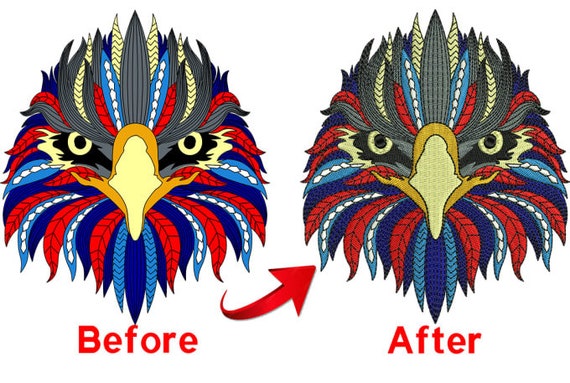Customized Digitizing for Embroidery: Tailored to Your Demands
Customized Digitizing for Embroidery: Tailored to Your Demands
Blog Article
Understanding the Needlework Digitizing Process: Your Ultimate Guide
Embroidery digitizing is a meticulous craft that calls for precision and experience to convert intricate layouts right into digital styles for machine needlework. As craftsmens embark on this journey to grasp the needlework digitizing procedure, a thorough understanding of the essentials sets the foundation for quality.

Recognizing Needlework Digitizing Essentials
Needlework digitizing fundamentals develop the structure whereupon detailed designs are translated into machine-readable formats for specific stitching. This initial step in the needlework digitizing procedure is critical for ensuring that the last stitched product is a loyal depiction of the initial layout. Comprehending needlework digitizing basics entails grasping vital principles such as stitch types, stitch direction, thickness, padding, and pull settlement.
Stitch kinds play an essential duty in figuring out the aesthetic and textural outcome of the stitched style. By selecting the proper stitch kind, whether it be satin, fill, or running stitch, digitizers can attain the desired impact and improve the overall high quality of the embroidery. In addition, sew instructions affects the flow and dimension of the design, while density figures out the spacing and coverage of the stitches.
Furthermore, rug stitching supplies security to the design by protecting the textile and protecting against distortion throughout the embroidery process. Draw compensation is another important consideration to counteract the all-natural tendency of fabric to contract when sewn. Grasping these embroidery digitizing fundamentals is fundamental for creating professional-quality embroidered products.
Choosing the Right Digitizing Software Application
Selecting the proper digitizing software program is a vital choice that substantially impacts the efficiency and top quality of the embroidery digitizing process. Digitizing for Embroidery. When choosing the appropriate digitizing software, it is vital to consider elements such as the intricacy of designs you plan to develop, the user-friendliness of the software program, the degree of consumer assistance used, and the compatibility with your embroidery maker
There are different digitizing software application options readily available in the market, varying from basic programs for novices to innovative software application for expert digitizers. Some popular selections consist of Wilcom EmbroideryStudio, Hatch Embroidery Software Application, and PulseID. These software provide a large range of devices and functions to assist you develop elaborate styles effortlessly.
Prior to deciding, it is a good idea to check out the various software application choices with cost-free tests or demonstrations to figure out which one best matches your requirements. Additionally, checking out evaluations and seeking suggestions from skilled digitizers can provide useful understandings right into the staminas and Extra resources weaknesses of each software (Digitizing for Embroidery). By very carefully examining your demands and contrasting the attributes of different digitizing software, you can make an enlightened selection that enhances your needlework digitizing workflow
Digitizing Tools and Methods

Optimizing Layout Setup for Embroidery
Understanding the ins and outs of design settings is fundamental in attaining ideal results in the needlework digitizing procedure, structure upon the foundation laid by understanding digitizing devices and methods. When enhancing style settings for needlework, it is vital to think about factors such as stitch kind, thickness, underlay, pull payment, and enrollment. Enrollment settings line up different elements of the style precisely, maintaining total design integrity.

Troubleshooting Common Digitizing Issues
When encountering usual digitizing concerns during the needlework procedure, it is vital to comprehend the origin and execute reliable remedies immediately. One common look here problem is stitch thickness issues, where stitches might be too thick, triggering the material to pucker, or too thin, causing spaces in the layout. Changing the stitch thickness setups in the digitizing software can help solve this problem.
One more frequent obstacle is thread breaks during the embroidery process. This can happen due site here to different reasons such as incorrect stress settings, boring needles, or utilizing low-grade thread. Making certain proper upkeep of the embroidery maker, consisting of regular needle modifications and tension adjustments, can lessen the event of string breaks.
Furthermore, style enrollment mistakes can cause misaligned elements within the embroidery design. Checking the design positioning in the digitizing software program and making needed changes before stitching can assist in avoiding this concern. By attending to these usual digitizing problems quickly and properly, you can make certain a smoother embroidery process and premium completed products.
Final Thought
In verdict, mastering the needlework digitizing procedure requires a strong understanding of the essentials, the best selection of software, and expertise of tools and strategies. Enhancing layout settings and repairing common digitizing concerns are essential action in making sure high-grade needlework outcomes. By adhering to these actions diligently, one can attain accuracy and performance in the digitizing procedure.
Report this page